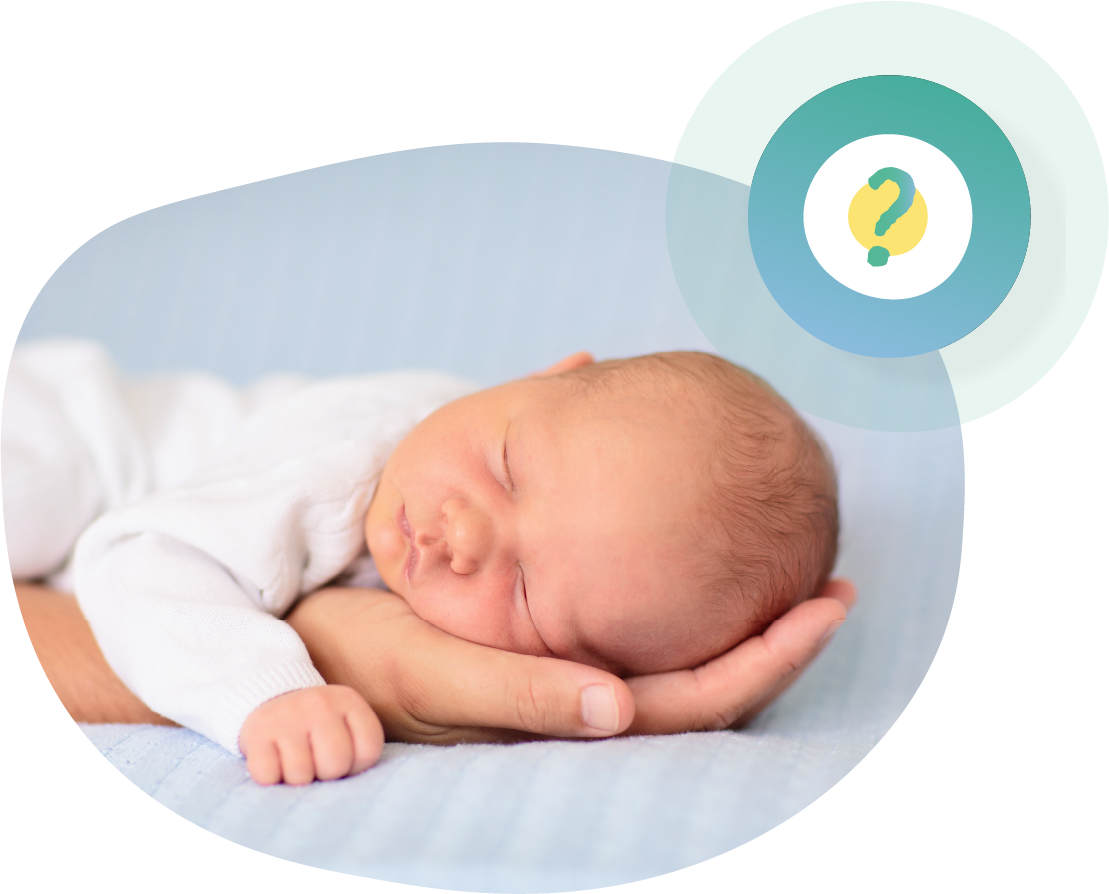

RSV stands for ‘respiratory syncytial virus’. It is a virus that occurs seasonally (usually from the winter months through to spring) and is easily spread.1,2 RSV infects many babies – nearly all children will have been infected with RSV by the age of two.3
Most cases of RSV infection are mild,4 but it can cause inflammation and congestion which may affect a baby’s breathing.5
People of all ages can catch RSV. However, certain groups of people including babies, the elderly, and people with underlying health conditions, are more at risk of developing severe illness.4,6
Most cases of RSV infection cause mild illness,4 but you should still be aware of any signs and symptoms that might indicate that your child has a more severe illness and needs medical attention.
You can learn more on our ‘Signs, symptoms and severity’ page here.
RSV is easily spread through coughs, sneezes, and close physical contact, like cuddles and kisses.4
An RSV infection can cause common cold-like symptoms (involving the nose and throat); most people may not realize they're infected and could easily spread it to others.4,6
RSV can also survive on hard surfaces like toys, cribs, and utensils for many hours, and spread to babies if they touch the virus and then touch their eyes, nose, or mouth.4
Research has shown that RSV is mostly spread to babies by older siblings or other children, and babies with older siblings are more likely to become infected with RSV than firstborns.7,8
An RSV infection usually causes a mild illness with symptoms like a cold, , but it can lead to severe illness in the lungs, such as bronchiolitis and pneumonia.4 These infections can cause swelling (inflammation) in the airways, which may make it harder for a baby to breathe.5
Signs that your baby is having difficulty breathing can include wheezing, grunting, or breathing faster than usual.5
Although uncommon, RSV infection can go from cold-like symptoms to more severe illness within a few days.10
CDC recommends you should call your healthcare professional if you notice that:11
Your child is having difficulty breathing.
Your child is not drinking enough fluids.
Your child is experiencing worsening symptoms.
This is not a complete list of all symptoms of RSV infection. Babies may experience other signs and symptoms.
If you're at all concerned about your baby, always seek medical advice.
Around 2 out of 3 babies will get infected with RSV by the age of one, and almost all children will be infected by the time they are 2 years old.12
RSV is highly contagious.2 Around 2 out of 3 babies will get infected with RSV by the age of one, and almost all children will be infected by the time they are 2 years old.12 RSV disease is unpredictable.13 Any infant—even if they were born full term and healthy—can be hospitalised in their first year.14-20
While most cases are mild,4 RSV infection can lead to respiratory illness, including lung infections such as bronchiolitis and pneumonia.4,5
Babies have small, fragile lungs, and their immune systems continue to mature and develop after birth. This may contribute to them being more vulnerable to developing serious illness due to RSV infection, compared to other age groups.21-25
While most cases of RSV infection cause mild disease, severe RSV disease can develop rapidly,14,10 and affect any baby.14-20 So, taking steps to reduce the chances of RSV transmission is important.
Antibiotics are often unnecessarily prescribed for viruses like RSV that cause respiratory (lung) infections.27
You can help prevent RSV infection through frequently washing your hands with soap for 20 seconds, disinfecting hard surfaces, toys, and utensils, coughing or sneezing into a tissue or your elbow, and keeping your baby away from people who are sick. Ask your doctor for more information about protection from RSV.
There are currently no routine RSV-specific treatments, and treatment is therefore mainly aimed at supporting the patient and relieving symptoms.
Talk to your doctor, nurse, or pharmacist about how to manage symptoms. If you're worried about your baby’s health, always seek medical advice.
1. Li Y et al. Lancet Glob Health 2019; 7: e1031–e1045.
2. Chatterjee A et al. Infect Dis Ther 2021; 10: S5–S16.
3. Simoes EAF. Lancet 1999; 354(9181): 847–852.
4. Piedimonte G and Perez MK. Pediatr Rev 2014; 35(12): 519–530.
5. Meissner HC. N Engl J Med 2016; 374(1): 62–72.
6. Coultas JA et al. Thorax 2019; 74(10): 986–993.
7. Jacoby P et al. Epidemiol Infect 2017; 145(2): 266–271.
8. Yamin D et al. Proc Natl Acad Sci USA 2016; 113(46): 13239–13244.
9. Zylbersztejn A et al. Euro Surveill 2021; 26(6): 2000023.
10. Smyth RL and Brearey SP. Encyclopedia of Respiratory Medicine. Bronchiolitis 2006; 268–275.
11. CDC. (n.d.). RSV symptoms. Retrieved from https://www.cdc.gov/rsv/about/symptoms.html.
12. Walsh E. Clin Chest Med 2017; 38(1): 29–36.
13. Bianchini S et al. Microorganisms 2020; 8(12): 2048.
14. Demont C et al. BMC Infect Dis 2021; 21(1): 730.
15. Sanchez-Luna M et al. Curr Med Res Opin 2016; 32(4): 693–698.
16. Kobayashi Y et al. Ped Intl 2021; 64: e14957.
17. Hartmann K et al. J Infect Dis 2022; 226: 386–395.
18. Yu J et al. Emerg Infect Dis 2019; 25(6): 1127–1135.
19. Thwaites R et al. Eur J Pediatr 2020; 179(5): 791–799.
20. Arriola C et al. J Pediatric Infect Dis Soc 2020; 9(5): 587–595 & SuppInfo.
21. Hussain M et al. Biochem Biophys Acta Mol Basis Dis 2017; 1863(12): 3226–3242.
22. Di Cicco M et al. Pediatr Pulmonol 2021; 56(1): 240–251.
23. Lambert L et al. Front Immunol 2014; 5: 466.
24. Esposito S et al. Hum Vaccin Immunother 2016; 12(7): 1700–1706.
25. Pickles RJ and DeVincenzo JP. J Pathol
26. Centers for Disease Control and Prevention (CDC). RSV in infants and young children. 2022. Available at: https://www.cdc.gov/rsv/high-risk/infants-young-children.html. Accessed: February 2023.
27. Obolski U et al. J Glob Antimircob Resist 2021; 27: 303–308.